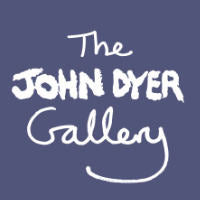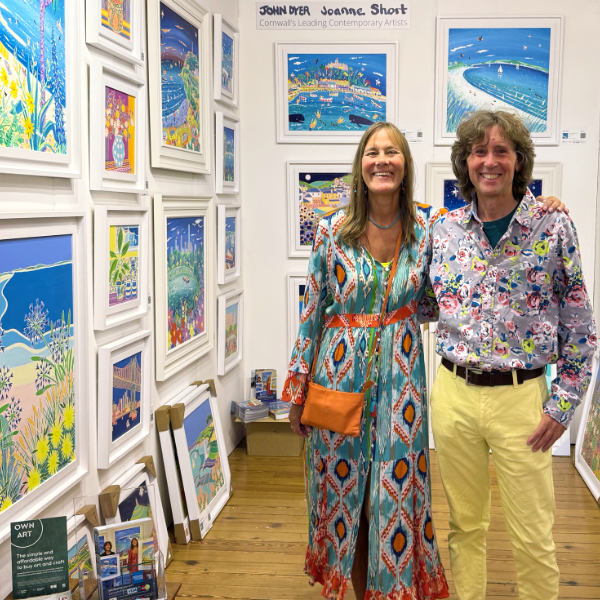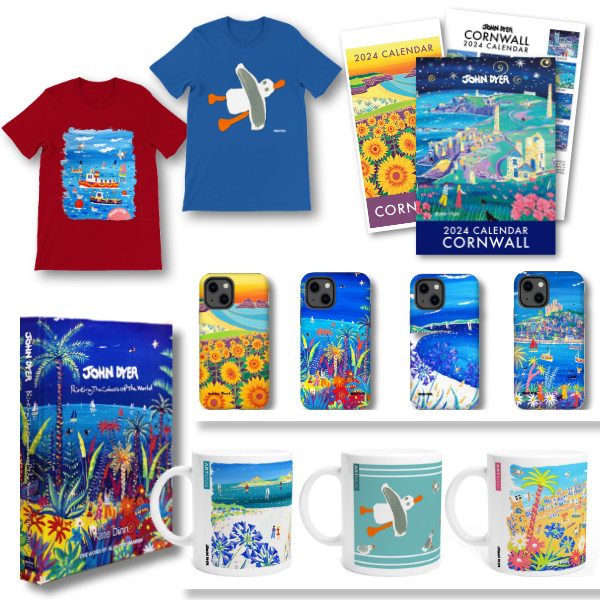Invest in British Art from Cornwall's Leading Artists | Free Worldwide Delivery
JOHN DYER
Original Paintings
New paintings available to buy online now by Cornwall's best loved artist.
JOANNE SHORT
Original Oil Paintings
New paintings available to buy online now by Cornwall's acclaimed colourist painter.
TED DYER
Original Oil Paintings
New paintings available to buy online by Cornwall's best known impressionist artist.
All Original Paintings
View all of the new original paintings that we have available to buy online now in our online gallery.
The ones you missed
View all of the recently sold original paintings by our Cornish artists John Dyer, Ted Dyer and Joanne Short.
Cornwall Art Prints
Museum-quality prints. Framed, Unframed, Signed & Wall Art Posters
September 5th - 7th 2025
Untitled Art Fair Chelsea, London
We will be exhibiting at the prestigious Untitled Art Fair, in Chelsea Old Town Hall.
June 6th - 8th 2025
St Ives Summer Exhibition 2025
New paintings by John Dyer & Joanne Short in the historic Porthmeor Studios in St Ives.
Christmas Exhibition 2024
A beautiful collection of new paintings by John Dyer & Joanne Short in the historic Porthmeor Studios in St Ives.
Explore our Previous Exhibitions
Enjoy exploring our previous exhibitions online and discover extraordinary paintings you can own today.
Press Coverage and Testimonials
Art Collectors Club.
Enjoy 5% off your first order, regular offers, exclusive exhibition invitations and artist and gallery updates in our monthly email newsletter.
In 2003 artist John Dyer was funded by Bioversity International (INIBAP) to travel to Costa Rica to paint the ethno-botanical story of the smallholding banana crop, cacao and home gardens. The paintings were used by the Bioversity for their annual report and for educational exhibition in Belgium and Scotland and John's original paintings were exhibited at the Eden Project in Cornwall.

Between 2000 and 2015, arising out of his work with Eden, John produced an incredibly varied and diverse series of ethno-botanical subjects, in which he explored the relationships between plants and people from the jungles of Costa Rica and the paddy-fields of the Philippines to the barren slopes of the Andes and the mysterious lives of those who live deep within the Amazon rainforest. Ethno-botany has a variety of definitions, in its wider interpretation extending to the use of plants in different cultures for medicinal, religious and folkloric purposes, but John chose to approach it mainly from the angle of food production. Having seen and painted many of the edible plants being cultivated at Eden,‘it was a natural progression for me as an artist to want to explore these crops in their native situation and to paint the human interaction of people with these plants’. While Eden had made a great job of recreating the conditions in which plants from around the world could thrive, it was less easy to capture the human voices of those whose lives were directly affected by the crops they grew. Dr Jo Elworthy, Eden’s Director of Interpretation, recognised that the best, and most direct, way to bring their stories to life was to enable them to be recorded visually in their own environment. The process of obtaining plants to go into the two Biomes had created many contacts between Eden and international food research organisations, and early in 2003 one of these,INIBAP (International Network for the Improvement of Banana and Plantain), asked John if they could use some of his work to illustrate the cover of its annual report.
"We asked John Dyer to paint bananas in Costa Rica because they are a smallholder crop – grown in people’s back gardens and farms along with lots of other fruits and vegetables. John’s pictures are all about diversity and bringing out what might pass unseen. In this case, it seems to have been scorpions!"
Charlotte Lusty. International Network for the Improvement of Banana and Plantain: 2003
Though bananas are grown at Eden (in the Humid Tropics Biome), John did not have to think twice before accepting the invitation to record their cultivation in one of their original locations. This could have been in one of many countries in the tropical or subtropical regions of Latin America, Africa or Asia, but it was agreed that the best place to get a real feel of bananas as a smallholder crop would be southern Costa Rica, near the Panama border where INIBAP has contacts on the ground. One of the main criteria was that banana cultivation in Costa Rica tends to be a smallholder crop grown in people's back gardens and farms along with lots of other fruits and vegetables. Though many millions of tonnes of bananas are grown around the world, only around 15% of the total crop is exported globally; the rest is grown for home consumption or local markets. This meant that some of the banana crop that John would be painting would literally be in people’s home gardens.
On his own, this trip could have turned out to be quite an ordeal as it meant living for several days in an isolated, open-sided hut deep in the jungle; but John was lucky in his travelling companion. Dr David Ashe, who had joined John, with their respective families, on happy painting trips in Tuscany in far more comfortable circumstances, offered to accompany him to Costa Rica and share the organisation, travel bookings, driving and subsistence. This not only gave David the opportunity to join John on another adventure, but also allowed him to document the trip. After their return, the seven paintings which John had managed to produce, against the odds, were exhibited at Eden, where John and David presented details of their trip, illustrated with slides and the DVD ‘To Eden and Beyond’ which David had put together. Detailed accounts of the trip were preserved in emails David sent home. These recall, sometimes in alarming detail, the challenges of John’s Amazon adventure 14 years earlier. ‘It took two days to fly to Costa Rica, travel across and down the country in ferocious rainstorms and finally arrive at our “Jungle House”; our home for the next six days. Although we both knew that we were to be stranded in the rainforest, I don’t think either of us were prepared for the reality of the heat, mosquitoes, huge beetles, spiders and the enormous variety of other crawling, flying, jumping and slithering fauna that was there to greet us.’
For five days, they alternated between the jungle, where John painted the local people tending the banana plants and also harvesting cacao pods, which have to be sliced open to extract the wet beans, and the nearby coast – a narrow strip of black volcanic sand lined by coconut palms. David described the beauties of the forest ‘with its canopy high overhead...humming birds during the day and fireflies at night’, and John’s painting practices: ‘He would stand in front of a blank canvas and appear to perform a mystical dance waving a dry paintbrush around, as he began to see what the painting might become. I was fascinated to watch the colour appear and the literally brilliant images emerge.’ But, as the week wore on, the weather deteriorated and the number of increasingly threatening bugs and other creatures in their hut proliferated. By Day 6, the rain was torrential and continuous; they realised that, in these conditions, there was little point in staying when John was unable to paint or David to film. A decision was taken to leave a day earlier than planned while the one road back to the nearest large town and airport was still open. There is little sign of the difficulties and dangers they encountered in John’s seven completed paintings, which, by the end of their stay, were unpinned from their stretchers and rolled up dry and safe in his wheelie-suitcase. Even the admittedly very large spiders in the jungle and crabs on the beach look fairly benign and cheerful (less so the scorpions). However, as David noted, John had painted slightly demonic black and red birds – a complete antithesis of John’s joyous dive-bombing Cornish seagulls – whose presence in his paintings increased in frequency over the week; perhaps a sign that John’s ever-present enthusiasm was starting to wane. ‘This,’ says David, ‘is as dark as a John Dyer painting ever gets!’
Explore our main art collections to find perfect original paintings, limited edition signed prints, open-edition prints, wall art prints and posters & artist designed gifts.
N.B. If you don’t see your confirmation email shortly, please check your spam or junk folder.
A stunning picture that was efficiently delivered to Amsterdam in a very short time frame.
From order to delivery the process was fast and efficient, especially as it was to the Netherlands.
Loved this case for my new iPhone 16 pro - it makes me smile and the vibrant colours are just gorgeous
Love it. So cheering on these dark days of winter. Thank you John.
I was looking for a print of st ives and came across John dyers work . I particularly like the colours and style of this piece , especially the fat seagulls . It’s complete fun in a frame and reminds us of happy days spent at the harbour
The print is fabulous, beautiful and my sister will love it. Thank you
Really like this picture as it brings brightness to our kitchen diner. We framed it with a white border and blue second border. Looks amazing
We love John’s pictures of France. We already have an original of Nice but bought this poster as it brings back so many wonderful memories.
Superb communication and attentiveness from gallery. The poster is of course wonderful.
Love this print - bright, sunny and makes one feel warm and happy!
Delivery was all easy and straightforward. Many thanks.
The print is even better in real life. It’s printed on beautiful quality paper which makes the colours really pop and the painting itself is simply charming. It brings so much joy to us. We love it! Thank you
A lovely art print bought as a memory of our holidays on the beautiful Isles of Scilly.
The frame is very well made and displays the art print beautifully. Ordering from John Dyer Gallery was simple and delivery swift. I would not hesitate to order from them again.
Thank you so much for the amazing customer service, and most beautiful painting of our favourite place
Absolutely beautiful painting. So thrilled with it. Completely amazing service: beautifully packaged, framed and safely delivered really quickly.
Lovely picture, bought 3 after our recent trip to Cornwall. Already thinking of getting more.
Have walked this coastal path from St Agnes to Chapel Porth and back countless time. I am now pleased that this fabulous print is the first thing I see every morning. Beautiful, happy colours. Nice frame. I’m now planning of ordering one of Mount’s Bay by same artist.




